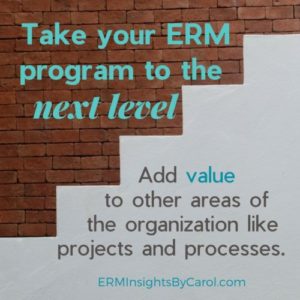The last two weeks have been focused on how you can free up existing ERM resources, either by resource allocation or revamping your risk assessment process. Now you can allocate those resources to better understand your enterprise risks and to create action plans and lower high risks to acceptable levels.
Once you’ve completed those activities, you can take your ERM program to the next level: adding value to other areas of the organization.
A Valuable Asset
Most organizations use ERM to identify risks that could have a negative effect on the strategic plan. But that’s just one context in which ERM can be applied.
As stated in our free 5 Effective Methods of Risk Identification eBook, a “context” is simply the area on which you are focusing your risk evaluation. In addition to strategic planning, contexts can include such areas as projects and processes.
Think back to your organization’s strategic plan. Every time significant changes are approved, a series of projects and initiatives are set in motion. Unfortunately, the directors, managers, and staff who work hard on these changes usually operate in silos. They’re not aware of how their activities can impact other projects, processes, or enterprise-level risks.
That’s where ERM comes in.
Your ERM team members have unique skill sets and training, as well as insight into the direction the organization is headed and all its key functions. These elements make your team a valuable asset to any strategy discussion involving projects or processes.
Assisting Projects
Projects are led by project managers (PMs) who have a clearly-defined role: to implement the project successfully. When identifying risks that could impact the scope, budget, or schedule, they usually look within the project itself—the charter, the plan, the resources assigned, the ability to meet deadlines, etc.
You can assist the PM by identifying risks that come from outside the project. For example, you may know of another initiative with competing resources or conflicting goals. Or you may be aware of external influences or emerging risks that could negatively affect customer satisfaction. Share this information with the PM and offer to help in the development of mitigation plans.
You may also identify risks the project introduces to the organization. Since the PM is tasked with completing the project, he may not want to track these types of risks. However, you can add them to your notes for further review. As you participate in projects, make note of patterns, overarching concerns, bottlenecks, dependencies, etc., that should be analyzed and included in your risk reports.
Assisting Processes
There are numerous processes within every organization, from product R&D to contract solicitation. Many times, the directors that oversee these processes are expected to introduce drastic changes in support of new organizational objectives. Project managers and staff trained in process improvement may be able to assist in the transition, but that is not always the case.
You can help the directors and managers ensure their changes are successful and in line with the new strategy. Work with them to identify risks that could have a negative impact on the process, as well as risks the process may introduce to the organization. Pay special attention to “hot-button” risks, such as those involving customer satisfaction, safety, and reputation. Use your organizational knowledge of various systems, people, and processes to make recommendations and develop mitigation plans.
While providing pertinent risk information can benefit any process, there are certain processes that can also benefit ERM. You may want to seek out these areas, especially the ones that involve the identification and assessment of risks, such as Project Management and Vendor Risk Management. These areas may provide valuable information you can use as inputs in your ERM process, or their risk results could be added to your risk information.
The Methodology
As you can imagine, it’s impossible to participate in every project or process. Instead, you should carefully choose the ones to get involved in. Look for projects that implement drastic changes or increase your hot-button risks. Partner with your PMO and process improvement groups so they know what you have to offer and can request your assistance when needed.
When you do get involved, adapt your ERM methodology to fit the circumstance. Remember that you are just a team member or consultant in this role. You should provide input and make suggestions, but the decisions will be left up to the PMs, directors, and managers in charge. This can be a stretching experience for risk managers, but it’s worth the effort!
Whether the context is strategic planning, projects, or processes, there’s really no end to the value ERM can bring to your organization.
What other areas besides strategic planning can ERM provide value in your organization?
Provide your comments below or join the conversation in LinkedIn.
And if you’re trying to determine additional ways you can apply ERM to build more value in your organization, please don’t hesitate to send an email or visit our services page to learn how we may be able to help.
About the author
Ashley Jones joined ERM Insights by Carol in June 2017. She graduated from Florida State University in 2003 with a B.A. in Risk Management and Insurance and obtained the Project Management Professional (PMP) designation in May 2012. Ashley has fourteen years of experience in the fields of insurance and risk management, most notably as a Senior Risk Analyst within the ERM department of a $7+ billion property and casualty insurance company. When she’s not working on project or risk management, Ashley is busy writing, blogging, teaching, and speaking on a wide variety of topics.









